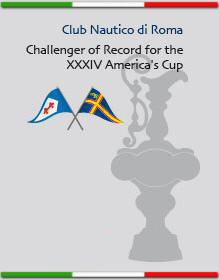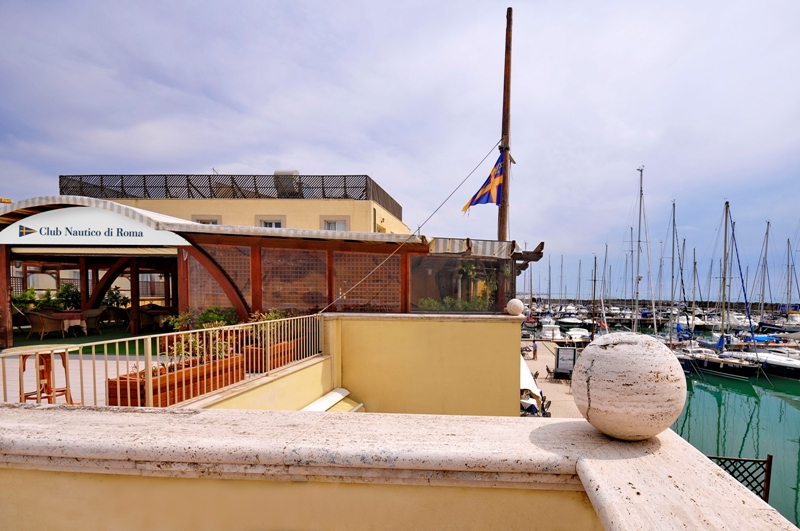What a Long Strange Trip
There were no bombshells in the America’s Cup 34 press conference held today in Rome’s Musei Capitolini, but the hour-long session had its moments. Most of all it got me to thinking how long it’s taken for a familiar idea to take root. That being, to normalize Cup racing, give it a structure, and establish a marketable schedule for an event that long ago outgrew the 19th century vision of a yacht club somewhere challenging another yacht club for a trophy.
Not everyone agrees that independent management should be the future of America’s Cup, or that it should be “normalized” according to the prescriptions I heard today. But this approach makes sense to me. We’ll still have yacht clubs, and challenges, but no yacht club is big enough to manage what the America’s Cup has become, no amount of talking and wishing has produced another sailing event to rival the America’s Cup, and our sport deserves something that works. This is it.

Moderator Cam Lewis, standing, with Russell Coutts and Vincenzo Onorato
I can remember Paul Cayard talking about this as a goal as he raced, unsuccessfully, at the 2000 match in Auckland. When he and Russell Coutts attempted, also unsuccessfully, to promote an international circuit in big catamarans, the vision was not far from what I heard described today by Coutts, representing the Defender, and Vincenzo Onorato, representing the Challenger. With the difference that we don’t have to invent the America’s Cup; we just have to reinvent it. The future as they laid it out will see racing in many parts of the world, culminating in an extended series of challenger races at the America’s Cup venue, staged out of what Coutts called, “a fantastic Cup Village; I think it is important to have that village for the fun factor, for the teams, for the commercial partners.”
The Challenger eliminations rounds will determine who gets a crack at the Cup itself. The Defender (or, perhaps, multiple Defender candidates) will not participate in Challenger racing “at the venue,” Coutts said, though I did not hear him rule out mixing the Defender with Challengers in pre-event racing, and I believe that is exactly what is intended. The bigger picture is allowing the Challengers to conduct their own affairs through a mutually-elected independent body—in stark contrast to former Defender Ernesto Bertarelli’s plan to take control of the Challenger trials himself, which takes us back to where the whole mess got started that we just got out of . . .
Predictably looking toward 2013 or 2014 for the next match, Coutts said, “I believe we have to address the Where before we can address the When.”
 It then fell to Onorato to announce that a protocol will be released by the end of August, with a design rule for the next generation of boats to be released by the end of September along with a Notice of Race, and the venue to be announced by the end of December.
It then fell to Onorato to announce that a protocol will be released by the end of August, with a design rule for the next generation of boats to be released by the end of September along with a Notice of Race, and the venue to be announced by the end of December.
Given that Coutts has remarked in the past that it will take two and a half years to build a cup village, I figure a match date of 2014 is more likely than 2013. A challenge period will open October 1 and remain open until January 31, 2011.

Club Nautico di Roma, at the mouth of the Tiber
Coutts added, “All the rules will be consolidated into a single document, finalized before the close of entries. That’s never been done before. By 2012 we expect to have racing in the new boats, and we are working now with the World Sailing Team Association (the usual-suspect challenge teams plus Louis Vuitton) to create a regular series of regattas that will have real meaning and will provide a sustainable commercial platform. It is our intention that the Race Committee in the future will have much more power to adjust course length for optimum television time. For any media company, the first thing to know is what time does the race start, and how long does it take. And then, our vision is to re-imagine broadcast coverage so that we bring fans onboard and place them in the heat of the action, shoulder to shoulder with the best sailors in the world.”
TURNING THE CORNER
What a long, strange trip it’s been, as a certain San Francisco band once put it. Russell Coutts has won the America’s Cup for New Zealand, for Switzerland, and now for the USA. The opening press conference of America’s Cup 34 was held in Italy, in Rome, because Onorato has challenged under the banner of the Club Nautico di Roma. The celebrated symbol of Rome, the ancient bronze statue of Romulus and Remus and the wolf, framed the setting along with the America’s Cup. Golden Gate Yacht Club vice commodore Ray Thomas noted that the Cup, first won by the schooner America in 1851, “is probably the youngest artifact in the building.”
Framing the future, Coutts promised, “All the teams will be involved in the design of the next boat. I’ve spoken to many sailors, and there is a desire to have boats that are physical and fast and versatile, something that will excite young people. They should be capable of sailing in three knots or thirty-five. We can’t afford another situation in which the Optis are sailing and America’s Cup boats are not. Bruce Nelson has been contracted to draft concepts for a monohull. Morelli & Melvin have been contracted to draft concepts for a multihull, and we intend to have a conference at which the fundamentals are discussed. This will not be a boat that the America’s Cup champions dictate.
“We think the protocol for AC 33 is a good starting point for looking forward,” Coutts said. “We have sent it out to many of the potential teams with a request for comment.”
The full press conference can be viewed online at americascup.com.
VENUE, VENUE, WHO’S GOTTA VENUE
Coutts acknowledged that the guy he works for, Larry Ellison, has strong ties to San Francisco Bay beyond the cut-and-dried fact that Ellison’s BMW Oracle Racing team won the Cup in the name of the Golden Gate Yacht Club, which sits on the cityfront of San Francisco, right where AC 34 should be held. And one of the most powerful aspects of Cup racing is that if you win the Cup, you win the venue.
The Cup went out for bid one time; we don’t need to go down that road again. Coutts also acknowledged, however, that the relevant government bodies and agencies still have work to do before it is possible to declare that SF Bay is the venue for the next match.
For my part, I remind you that the San Francisco Bar Pilots have said they can deal with the commercial shipping issues (“We welcome an America’s Cup with open arms”), and I can testify that public enthusiasm is running high. Earlier this week I did a lunchtime talk for the employees and friends of the Port of San Francisco, where the turnout and response proved that it’s not just sailors who are keen on this, and there is an appetite on the part of many people to understand this strange phenomenon that is, was, and will remain the signature event of our sport.
Traditionally, America’s Cup spectators have faced a long boat ride to the race course. That’s why this opportunity is unique, and huge. Think back a few years to the Moët Cup, with AC boats racing on San Francisco Bay per Chris Ray’s image above.
Baby, we’ve already done proof of concept.
BOTTOM LINE
Regular events will raise costs, Coutts said, but they will also increase sponsorship fulfillment opportunities. “Personnel costs are about 65 percent of campaign costs,” he said. “If we have blackout periods on the sailing, we directly reduce those costs.”
And then the inevitable question, What if Alinghi wants to play?
They’re welcome, Coutts said: “I’ve been wanting to talk to them for years.”


